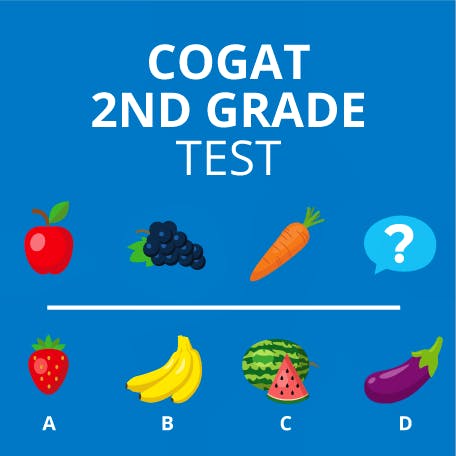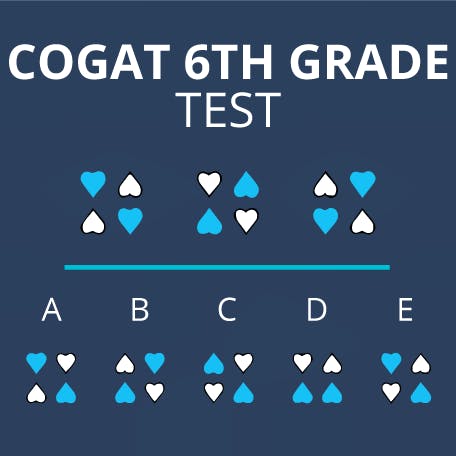CogAT Test Scores: Understanding Your CogAT Score
Updated November 29, 2023

- How Are CogAT Scores Presented?
empty
empty
empty
empty
empty
empty
- CogAT Scores Explained
- CogAT Scores Explained – CogAT Score Chart
empty
- How to Improve Your CogAT Scores
- Frequently Asked Questions
- Final Thoughts

The CogAT raw score represents how many questions were answered correctly on the CogAT test. This information is used to create the Universal Scale Score (between 100 and 150), which you will see on your child’s CogAT score report.
Here is an image of a typical score report:
| Abilities | Age Scores | ||
|---|---|---|---|
| Standard Age Score | Age Stanine | Age Percentile Rank | |
| Verbal | 106 | 6 | 65 |
| Quantitative | 112 | 7 | 77 |
| Non-verbal | 94 | 4 | 35 |
| Composite | 104 | 8 | 80 |
Source: www.testprep-online.com
CogAT scores are calculated in line with your child’s age rather than their school grade level.
As well as the raw score, your child’s CogAT score report will include a:
- Standard Age Score (SAS)
- Universal Scale Score (USS)
- Percentile Rank (PR)
- Age Stanine Score (S)
You can learn more about these terms below.
In this article, you can find out how to read and interpret CogAT scores and how CogAT score interpretation can be used to gain a clearer understanding of your child�’s CogAT test results.
How Are CogAT Scores Presented?
Your child’s unique CogAT test score meaning is based on the following information.
Raw Score
This part of the report tells you how many questions your child answered correctly. Note that giving an incorrect answer to a question does not lead to points being deducted. The raw score is simply the number of correct answers given.
Universal Scale Score (USS)
Once your child’s Raw Score has been worked out, this is converted to a normalized standard score, which is referred to as the Universal Scale Score.
For the CogAT test, a normalized standard scale is applied consistently from kindergarten up to 12th grade.
Working out the USS involves a statistical calculation that serves to ensure CogAT test scores are not influenced by the variations in difficulty over the different forms of the test. The USS is between 100 and 150.
Your child will receive a separate USS for each of the test batteries (verbal, non-verbal and quantitative reasoning skills). This information can be used to highlight any areas of strength and weakness in your child’s CogAT test performance.
The Composite VQN score is an average of your child’s three USS.
Standard Age Score (SAS)
This is a normalized age score for all of your child’s USS. The mean or average SAS is 100, the maximum possible SAS is 160 and the standard deviation is 16.
For example, if your child achieves a score of 100 on the quantitative reasoning battery, they are considered to be working to the standard rate of potential and development in that area.
A child who achieves 150 in the same test battery is considered to have a higher rate of potential and development in that area.
Age Percentile Rank (PR)
This part of the score report can be used to compare your child’s test performance against other students in their age and grade group.
A PR of 75 means that your child performed better than 75% of children in their age and grade group. A PR of 90 means that your child performed better than 90% of children in their age and grade group.
APR Graph
This is an illustration of your child’s composite and individual battery scores. It shows the results for each battery within the test.
Age Stanine (S)
The S score is shown as a number between 1 and 9, with 1 being the lowest possible score and 9 the highest possible score.
This part of the test report is a very simplified version of your child’s test results. It is normalized for both your child’s grade and age group.
Stanine scores offer a broad overview of your child’s overall academic ability.
They are usually interpreted as follows:
| Stanine Score | Overall Academic Ability |
|---|---|
| 9 | Very High |
| 7 to 8 | Above Average |
| 4 to 6 | Average |
| 2 to 3 | Below Average |
| 1 | Very Low |
CogAT Scores Explained
CoGAT Score Profiles can be used to understand your child’s overall CogAT performance, along with their academic strengths and weaknesses.
Here is an example for having CogAT scores explained:
7B(V+)
In this example, '7' represents the student’s Median Stanine Score, for example, the median stanine score across the three test batteries.
For example, if the student receives a stanine score of 6 on the non-verbal battery, 7 on the quantitative battery and 8 on the verbal battery, this gives a median stanine score of 7.
The 'B' represents the student’s Score Pattern Indicator. This part of the score can be used to gain insight into a student’s pattern of academic ability:
| Letter | Description |
|---|---|
| A | The student’s ability is the same across all three CogAT test batteries |
| B | In one test battery, the student scored higher or lower than the other two batteries. This means they have demonstrated a relative strength or weakness |
| C | Two of the student’s scores contrast with each other, which demonstrates a relative strength and a relative weakness |
| E | There is an extreme difference in the student’s scoring between test batteries. At least two of their scores are different by 24 or more raw score points |
The 'V' stands for Verbal Battery in the example above. This part of the score profile shows which area (if any) the student has demonstrated a relative strength or weakness in.
In this example, the student has demonstrated a relative strength in the verbal test battery.

| Stanine Score | Percentile Rank | Description |
|---|---|---|
| 1 | 1 to 3 | Very low score. Bottom 4%. Very poor cognitive abilities compared to others within the peer group |
| 2 | 4 to 10 | Well below average cognitive abilities |
| 3 | 11 to 22 | Below-average cognitive abilities |
| 4 | 23 to 39 | Slightly below-average cognitive abilities |
| 5 | 40 to 59 | Average cognitive abilities |
| 6 | 60 to 76 | Slightly above average cognitive abilities |
| 7 | 77 to 88 | Above average cognitive abilities |
| 8 | 89 to 95 | Well above average cognitive abilities |
| 9 | 96 to 99 | Very high score. Top 4%. Superior cognitive abilities compared to others within the peer group |
What Is the CogAT Gifted Score?
If your child wants to join their school’s gifted and talented program, they will probably need to achieve a combined percentile score of 95 or a percentile score of 97 or above in one of the test batteries.
However, the gifted CogAT score chart does vary between schools. If your child is interested in gifted and talented programs, you should discuss the minimum requirements directly with their preferred school program.
How to Improve Your CogAT Scores
Here are some tips on how to help your child improve their CogAT score.
Step 1. Familiarize With the CogAT Test Environment
Completing CogAT practice tests is a good way for your child to become familiar with the overall test.
Encouraging your child to complete practice tests under exam conditions will help them to understand what to expect on the day of the test.
This should help to reduce any exam-day nerves, which means they will feel more relaxed on the day of the test.
Step 2. Understand the CogAT Scoring System
Gaining a good understanding of the CogAT test score meaning is one of the best ways to help prepare your child for the test.
Each time your child sits a practice CogAT test, work with them to identify their areas of strength and weakness.
You can identify this information by looking at their CogAT Score Profile and USS for each of the test batteries.
Once you have identified areas of strength and weakness, work with your child to prepare a revision program to help them improve in any areas of weakness.
Step 3. Review Previous CogAT Scores
If your child has sat the CogAT test before, spend time reviewing their previous score. This is another good way to identify areas of strength and weakness in their academic ability.
Learning to understand CogAT scores is important. The CogAT score report includes several different types of scores, including the raw score, standard age score, stanine score and percentile rank. Knowing the definition of these terms and how to interpret the CogAT score percentile chart will help you to gain an understanding of CogAT scores.
CogAT results are issued to parents following completion of the test.
CogAT scores are generally deemed to be valid for two to three years after taking the test. However, CogAT is not a pass-or-fail test, and not all schools administer it to all students. In some cases, the CogAT is only used to determine suitability for the gifted and talented program.
The CogAT score considered gifted varies between schools and programs. Generally speaking, a combined percentile score of 95 or a percentile score of 97 or over in one of the test batteries is considered gifted. However, you should always check with your child’s school or gifted and talented program regarding requirements for a gifted CogAT score chart.
If you are looking at the Standard Age Score, a score of 100 is considered to be average. The highest possible SAS is 160, so anything between 100 and 160 is considered a good score. If you are looking at the Stanine score, a score of 7 or over is generally considered to be a good score.
The highest Standard Age Score on CogAT is 160.
The composite score in CogAT is calculated using national age and grade norms. This provides a benchmark for scores to be compared against other students in the same age and grade group.
Final Thoughts
At first glance, the CogAT scores can seem overwhelming. There are several different terms to know, and it can be difficult to know how to interpret the information in a CogAT score percentile chart.
Using the information in this article, you can easily read your child’s CogAT score and use this data to identify their areas of academic strengths and weaknesses.














